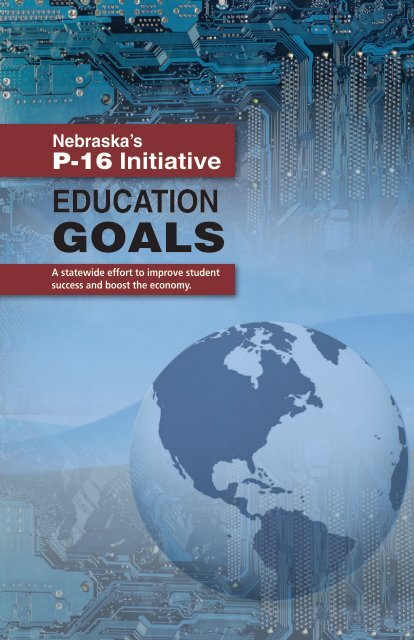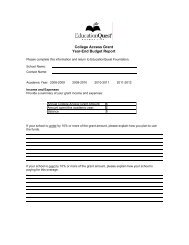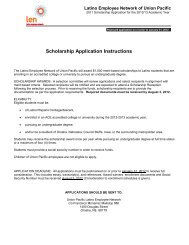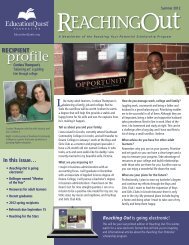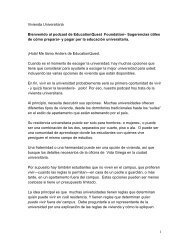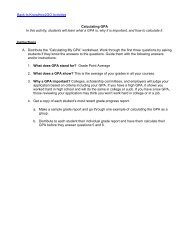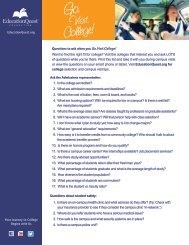P-16 Initiative EDUCATION GOALS - Educationquest Foundation
P-16 Initiative EDUCATION GOALS - Educationquest Foundation
P-16 Initiative EDUCATION GOALS - Educationquest Foundation
Create successful ePaper yourself
Turn your PDF publications into a flip-book with our unique Google optimized e-Paper software.
Nebraska’s<br />
P-<strong>16</strong> <strong>Initiative</strong><br />
<strong>EDUCATION</strong><br />
<strong>GOALS</strong><br />
A statewide effort to improve student<br />
success and boost the economy.
1<br />
“ We need to<br />
prepare our<br />
students for the<br />
21st century,<br />
not the 19th century.<br />
Governor Dave Heineman<br />
Governor Dave Heineman made this statement in August 2009 as he and education<br />
leaders announced eight new education goals that will prepare Nebraska students for a<br />
successful future while helping to ensure our state’s economic vitality.<br />
Now more than ever, Nebraska’s economic future depends on the size and quality of<br />
its workforce. Advances in technology, science and communication have created an<br />
immense need for well-educated workers across a broad spectrum of businesses, trades,<br />
service-providers, and government agencies. For the uneducated, or under-educated,<br />
this new economy presents enormous challenges and an uncertain future. For the welleducated,<br />
opportunities are nearly unlimited.<br />
To succeed, Nebraska’s young people must attain academic and technical knowledge,<br />
adapt to an ever-changing marketplace, and communicate effectively. No matter what<br />
field they choose, their level of education and marketable skills will determine their<br />
ability to financially support themselves and their families.<br />
From the state’s perspective, the success of our young people requires a high-quality,<br />
rigorous educational system that helps all students achieve at high levels and<br />
encourages lifelong learning. Only a highly skilled, technologically literate workforce<br />
can keep the Nebraska economy vital, vigorous and competitive.<br />
Nebraska has the same opportunities as other states and nations to compete in<br />
advanced biotechnology, nanotechnology, new energy technologies, agricultural<br />
and environmental advances, manufacturing, and international trade. To compete<br />
successfully, however, we must create a new norm in which all of our students pursue<br />
education beyond high school. It must become increasingly common for students to<br />
attain two- and four-year degrees.<br />
Nebraska must work quickly to achieve this level<br />
of educational excellence. Recently, Governor<br />
Dave Heineman, who chairs the Nebraska P-<strong>16</strong><br />
<strong>Initiative</strong>, joined with Senator Greg Adams,<br />
Chair of the Legislature’s Education Committee,<br />
Roger Breed, Commissioner of Education,<br />
Liz Koop, President and CEO of EducationQuest<br />
<strong>Foundation</strong>, and J.B. Milliken, President of the<br />
University of Nebraska to launch an ambitious<br />
new effort to achieve these outcomes.<br />
”<br />
Members of the P-<strong>16</strong> Executive Committee:<br />
Greg Adams, Roger Breed, Governor Heineman,<br />
J.B. Milliken and Liz Koop.
To begin the process of achieving educational excellence, Nebraska’s P-<strong>16</strong> <strong>Initiative</strong><br />
has identified eight goals aimed at improving Nebraska’s educational system:<br />
1.<br />
2.<br />
3.<br />
4.<br />
5.<br />
6.<br />
7.<br />
8.<br />
Adopt a college and career preparation core curriculum that requires<br />
four years of English and three years each of math, science and social<br />
studies in Nebraska school districts by the 2014-2015 school year.<br />
Eliminate the academic achievement gap between Nebraska’s K-12<br />
Caucasian students and its African American, Hispanic, and Native<br />
American students.<br />
Develop an effective longitudinal data system that provides information<br />
on the Nebraska education system from preschool through post-graduate<br />
degree-attainment and entry into the workforce to help align resources<br />
with strategic goals.<br />
Attain a high school graduation rate of 90% or higher in each Nebraska<br />
high school.<br />
Improve Nebraska’s college-going rate to the top-10 tier nationally.<br />
Provide affordable access for Nebraska students to attend Nebraska’s<br />
postsecondary institutions.<br />
Improve time to degree-completion and increase graduation rates of<br />
Nebraska’s postsecondary institutions.<br />
Provide all students with the science, technology and math skills needed<br />
to succeed in postsecondary education or the 21st-century workforce; and<br />
increase the number and diversity of individuals who pursue careers as<br />
educators and professionals in the areas of science, technology,<br />
engineering, and math.<br />
Each goal is explained in greater detail in this document. Committees have worked over<br />
the past several months to develop strategies for each goal.<br />
Nebraska P-<strong>16</strong> encourages you to become active in the process of implementing these goals<br />
in the coming months and years – and welcomes your questions and suggestions.<br />
2
3<br />
GOAL<br />
1 Adopt<br />
a college and career preparation core curriculum<br />
that requires four years of English and three years each<br />
of math, science and social studies in Nebraska school<br />
districts by the 2014-2015 school year.<br />
Background:<br />
If Nebraska students take a rigorous curriculum in high school, they are much<br />
more likely to succeed in a two- or four-year college and in the workplace. A<br />
challenging course of study in English, math, science and social studies will help<br />
students succeed in first-year college courses, will improve the probability that<br />
they will graduate and will reflect college and employer expectations. It will also<br />
help prepare students to obtain well-paying jobs and advance in their careers.<br />
Nebraska is a leader in terms of the number of students taking the ACT, and<br />
collectively, our students have the highest average ACT score among states where<br />
more than 75 percent of students take the test. In 2010, 73 percent of Nebraska<br />
high school students (<strong>16</strong>,172 students) took the ACT test, which measures college<br />
readiness. Their average score was 22.1 – just over one point above the national<br />
average of 21.0. Yet only 29 percent of these students met ACT-recommended<br />
college readiness benchmarks in English, reading and science.<br />
Nebraska needs to raise academic expectations for students and tie high school<br />
requirements to the expectations of colleges and employers.<br />
Goal 1 Updates and Strategies:<br />
n On October 8, 2009, the Nebraska Board of Education adopted the P-<strong>16</strong><br />
Graduation Requirement Resolution along with corresponding changes to<br />
Rule 10. Rule 10 provides administrative regulations school districts use to<br />
establish high school graduation requirements.<br />
n On January 14, 2010, Governor Heineman approved Rule 10 changes.<br />
n By the 2014-2015 school year, all Nebraska school districts will have<br />
completed the necessary changes to be in compliance with the increased<br />
graduation requirements.
Goal 1 Leaders:<br />
Governor Dave Heineman and State Senator Greg Adams<br />
Goal 1 Committee:<br />
Wendy Boyer, Greater Omaha Chamber of Commerce<br />
Matt Blomstedt, Educational Service Unit Coordinating Council<br />
John Bonaiuto, Nebraska Association of School Boards<br />
Robert Evnen, Nebraska State Board of Education<br />
Jim Griesen, University of Nebraska-Lincoln<br />
Krista Kjeldgaard, Nebraska Department of Education<br />
Catherine Lang, Nebraska Department of Labor<br />
Jim Lewis, University of Nebraska-Lincoln<br />
Ann Masters, Nebraska Department of Education<br />
Ann Nickerson, Nebraska PTA<br />
Gerry Oligmueller, Nebraska State Budget Office<br />
Deb Romanek, Nebraska Department of Education<br />
Terry Snyder, Fremont Public Schools<br />
Korinne Tande, Nebraska State College System<br />
Kerry Winterer, Nebraska Department of Health and Human Services<br />
“<br />
raise academic expectations<br />
Nebraska needs to<br />
for students and tie<br />
high school requirements,<br />
to the expectations of<br />
colleges and employers. ”<br />
4
5<br />
GOAL<br />
2 Eliminate<br />
the academic achievement gap between<br />
Nebraska’s K-12 Caucasian students and its African<br />
American, Hispanic, and Native American Students.<br />
Background:<br />
The 2009 results of the National Assessment of Educational Progress (NAEP) showed a<br />
38 point difference in eighth-grade math achievement between Caucasian and African<br />
American students, placing Nebraska 46th among the states on this measure. The NAEP<br />
results for Hispanic students placed Nebraska 40th in the nation with a 29 point gap.<br />
The test results in reading show Nebraska ranking 33rd in the nation, with a gap of 27.9<br />
points between Caucasian and African American students.<br />
These gaps reveal that students of color and economically disadvantaged students are<br />
not succeeding in our current system.<br />
Ten points on the NAEP equal approximately one grade level. This means that, on the<br />
2009 measure, African-American students are nearly four grades behind their Caucasian<br />
peers. Hispanic students are nearly three grades behind. Nebraska must attack these<br />
gaps with greater effectiveness.<br />
Goal 2 Updates and Strategies:<br />
n Nebraska has an approved process to identify persistently lowest-achieving<br />
schools (PLAS), award grants, and provide technical assistance.<br />
n The Nebraska Department of Education gathered data from Nebraska Student and<br />
Staff Record System to analyze achievement gaps and is undertaking activities to<br />
address identified needs:<br />
• Developing a state rule and requirement for serving English Language<br />
Learners, the lowest achieving group of students on the new state reading test.<br />
• Addressing known contributors to low achievement that include high<br />
mobility and excessive absenteeism.<br />
• Providing training and technical assistance in the analysis and use of data<br />
to target instruction.<br />
n By December 2011, the Nebraska Board of Education will provide a state<br />
accountability plan to report the performance of all schools and districts using<br />
results from the Nebraska Statewide Accountability (NeSA) assessment, student<br />
growth measures, and graduation rates.
Goal 2 Leader:<br />
Commissioner of Education Roger Breed<br />
Goal 2 Committee:<br />
Tim Alvarez, University of Nebraska-Lincoln<br />
Ken Bird, Building Bright Futures <strong>Foundation</strong><br />
John Bonaiuto, Nebraska Association of School Boards<br />
Wendy Boyer, Greater Omaha Chamber of Commerce<br />
David Brown, Greater Omaha Chamber of Commerce<br />
Thomas Christie, NAACP Education Committee and Lincoln Public Schools<br />
Michael Dulaney, Nebraska Council of School Administrators<br />
Robert Evnen, Nebraska State Board of Education<br />
Carol Fichter, Nebraska Department of Education<br />
Jesse Foster, Nebraska Department of Education<br />
Judi gaiashkibos, Nebraska Commission on Indian Affairs<br />
Msgr. James Gilg, Omaha Archdiocesan Schools<br />
Scott Hazelrigg, Nebraska Association of School Boards<br />
Melody Hobson, Nebraska Department of Education<br />
Amber Hunter, University of Nebraska-Lincoln<br />
Barry Kennedy, Nebraska Chamber of Commerce and Industry<br />
Catherine Lang, Nebraska Department of Labor<br />
Mary Ann Losh, Nebraska Department of Education<br />
John Mackiel, Omaha Public Schools<br />
Mary McNamee, University of Nebraska Medical Center<br />
Jolene Palmer, Nebraska Department of Education<br />
Carol Rempp, Nebraska Department of Education<br />
Richard Schoonover, Nebraska Department of Education<br />
Lazaro Spindola, Latino American Commission<br />
Bob Whitehouse, University of Nebraska Board of Regents<br />
Linda Zinke, Nebraska Association for the Education of Young Children<br />
6
7<br />
GOAL<br />
3 Develop<br />
an effective longitudinal data system that<br />
provides information on the Nebraska education<br />
system from preschool through post-graduate degreeattainment<br />
and entry into the workforce to help align<br />
resources with strategic goals.<br />
Background:<br />
Resources to support quality educational systems at all levels, preschool through college,<br />
are precious even under the best of economic conditions. Making sound decisions<br />
on how to best target available resources in the future requires measurable and<br />
demonstrable information on the effectiveness of our current programs.<br />
Nebraska spends over $1 billion per year on public education (K-12 and postsecondary).<br />
For citizens and policy makers to determine whether these funds are allocated<br />
appropriately, the state needs a more comprehensive longitudinal data system.<br />
Goal 3 Updates and Strategies:<br />
n A Memorandum of Understanding was developed that allows data sharing<br />
between the Nebraska Department of Education, University of Nebraska,<br />
Nebraska State College System, and Nebraska Community Colleges.<br />
n A Goal 3 Implementation Committee was formed of representatives of<br />
postsecondary institutions, Department of Labor, Nebraska State Education<br />
Association, Nebraska’s Coordinating Commission for Postsecondary Education,<br />
and non-public educators. The Committee developed recommendations for the<br />
Data Governing Council which includes the Commissioner of Education, President<br />
of the University of Nebraska, Chancellor of the Nebraska State College System,<br />
and Executive Director of the Nebraska Community College Association.<br />
The Council adopted these recommendations:<br />
1. Create a postsecondary data system that will:<br />
• Provide a unique identifier for all students at all levels of Nebraska education<br />
while assuring resolution of privacy issues.<br />
• Track student progress through Nebraska’s public education system, P-20,<br />
including enrollment, degree completion, and demographic data for all schools,<br />
public colleges and universities.
• Match student records between P-12 and higher education systems.<br />
• Report back to high schools on college readiness of their graduates.<br />
• Match student records with data on employment.<br />
• Audit statewide data to ensure quality, validity and reliability.<br />
• Ensure security and responsible use of data through a data governance<br />
committee.<br />
• Promote development of solutions to Nebraska’s most significant<br />
educational challenges.<br />
2. Create a Nebraska system that meets Federal requirements.<br />
• A technical team made up of representatives from each postsecondary<br />
institution has begun assigning the NDE Student ID to all postsecondary<br />
students and is defining data elements that meet State Fiscal Stabilization<br />
Fund requirements.<br />
Goal 3 Leader:<br />
Commissioner of Education Roger Breed<br />
Goal 3 Committee:<br />
Matt Blomstedt, Educational Service Unit Coordinating Council<br />
Wendy Boyer, Greater Omaha Chamber of Commerce<br />
Craig Christiansen, Nebraska State Education Association<br />
Richard Christie, University of Nebraska at Omaha<br />
Ralph De Ayala, University of Nebraska-Lincoln<br />
Carol Fichter, Nebraska Department of Education<br />
Msgr. James Gilg, Omaha Archdiocesan Schools<br />
Melody Hobson, Nebraska Department of Education<br />
Marshall Hill, Coordinating Commission for Postsecondary Education<br />
Sharon Katt, Nebraska Department of Education<br />
Catherine Lang, Nebraska Department of Labor<br />
Jim O’Hanlon, University of Nebraska-Lincoln<br />
Carol Rempp, Nebraska Department of Education<br />
Terry Rohren, Nebraska Department of Education<br />
Richard Schoonover, Nebraska Department of Education<br />
Lazaro Spindola, Latino American Commission<br />
Linda Zinke, Nebraska Association for the Education of Young Children<br />
8
9<br />
GOAL<br />
4 Attain<br />
a high school graduation rate of 90% or<br />
higher in each Nebraska high school.<br />
Background:<br />
Traditionally, Nebraska high school graduation rates have been regarded as<br />
exemplary. However, all 50 states are now using new, more rigorous standards<br />
for measuring graduation rates. While Nebraska’s rate now stands at 90 percent,<br />
estimates show it will drop to approximately 78 percent when the new rate is<br />
announced in late fall of 2011.<br />
A major issue in improving on this measure is the rate of high school dropouts.<br />
Currently, about 5,000 students in Nebraska drop out of high school each year.<br />
Fourteen school districts account for 70 percent of these dropouts.<br />
Goal 4 Updates and Strategies:<br />
n Obtained a listing of current graduation rates calculated by the National<br />
Center for Education Science (NCES).<br />
n Beginning with the 2010-11 school year, will calculate the graduation<br />
rate for Nebraska high schools using a four-year adjusted cohort graduation<br />
rate formula.<br />
n Nebraska plans to collect data on 5-year and 6-year graduation rates to<br />
gather additional information about Nebraska’s high school graduation rates.
Goal 4 Leaders:<br />
Senator Greg Adams and Governor Dave Heineman<br />
Goal 4 Committee:<br />
John Bonaiuto, Nebraska Association of School Boards<br />
Wendy Boyer, Greater Omaha Chamber of Commerce<br />
Roger Bruning, University of Nebraska-Lincoln<br />
Richard Christie, University of Nebraska at Omaha<br />
Thomas Christie, NAACP Education Committee and Lincoln Public Schools<br />
Craig Christiansen, Nebraska State Education Association<br />
Michael Dulaney, Nebraska Council of School Administrators<br />
Nancy Edick, University of Nebraska at Omaha<br />
Robert Evnen, Nebraska State Board of Education<br />
Kim Hawekotte, University of Nebraska at Omaha<br />
Sue Henry, Nebraska Department of Education<br />
Barry Kennedy, Nebraska Chamber of Commerce and Industry<br />
Marjorie Kostelnik, University of Nebraska-Lincoln<br />
John Mackiel, Omaha Public Schools<br />
Richard Schoonover, Nebraska Department of Education<br />
Lazaro Spindola, Latino American Commission<br />
Linda Zinke, Nebraska Association for the Education of Young Children<br />
Currently, about<br />
5,000 students<br />
in Nebraska drop out of<br />
high school<br />
each year.<br />
10
11<br />
GOAL<br />
5 Improve<br />
Nebraska’s college-going rate to the top-10<br />
tier nationally.<br />
Background:<br />
In a report released in June 2010 from the Center on Education and the Workforce<br />
at Georgetown University, research indicated that by 2018, 66 percent of the jobs<br />
in Nebraska will require a postsecondary education.<br />
Nebraska’s college-going rate is 65.5 percent, ranking our state 18th in the<br />
nation. This includes students who matriculate at all types of postsecondary<br />
institutions (two-and four-year colleges, universities, private, public, for-profit<br />
and nonprofit). The tenth-ranked state (Connecticut) has a college-going rate of<br />
69 percent, which means Nebraska needs to improve to 69 percent to be in the<br />
top-ten tier. This is, however, a moving target because 49 other states are also<br />
working to increase their college-going rates.<br />
Goal 5 Updates and Strategies:<br />
n Nebraska’s high schools, colleges, and private entities will communicate a<br />
comprehensive college-going message to students and families beginning<br />
with the 2010-11 school year.<br />
• The College Access Summit, held May 12, 2011, served as a<br />
statewide conversation regarding the work needed to encourage<br />
increased college going by Nebraska students.<br />
n During the 2011-12 school year, implement a “Governor’s Outstanding<br />
College Access Award” for high schools that provide college access activities<br />
for students and for colleges that partner with high schools to provide<br />
college access opportunities for students.<br />
n Beginning in the fall of 2010, develop and coordinate a statewide college<br />
visit activity for high school juniors, seniors and adult learners.<br />
• In September 2010, The P-<strong>16</strong> Co-Chairs conducted statewide news<br />
conferences promoting the importance of campus visits. The campaign is<br />
called Go.Visit.College!<br />
• A recent informal survey of Nebraska counselors shows that<br />
as of March 31, 2011:<br />
n 30 high schools have conducted 73 group visits<br />
n 24 schools plan to conduct group visits before the end of the school year
Goal 5 Leaders:<br />
Liz Koop and J.B. Milliken<br />
Goal 5 Committee:<br />
Julie Agard, University of Nebraska at Kearney<br />
Dennis Baack, Nebraska Community College Association<br />
Richard Baier, Nebraska Department of Economic Development<br />
Ken Bird, Bright Futures <strong>Foundation</strong><br />
Matt Blomstedt, Educational Service Unit Coordinating Council<br />
Nancy Bond, Omaha Public Schools<br />
Stan Carpenter, Nebraska State College System<br />
David Conway, University of Nebraska at Omaha<br />
Christine Denicola, EducationQuest <strong>Foundation</strong><br />
Pete Ferguson, Lincoln Public Schools<br />
Nathan Fuerst, University of Nebraska-Lincoln<br />
Amy Goodburn, University of Nebraska-Lincoln<br />
Marshall Hill, Coordinating Commission for Postsecondary Education<br />
Stephen Joel, Lincoln Public Schools<br />
Barry Kennedy, Nebraska Chamber of Commerce and Industry<br />
Tip O’Neill, Association of Independent Colleges & Universities of Nebraska<br />
Linda Pratt, University of Nebraska<br />
Bob Whitehouse, Board of Regents<br />
Increasing the<br />
college-going rate<br />
in Nebraska is important because having a<br />
well-educated population<br />
is key to competing<br />
successfully in a global,<br />
knowledge-based<br />
economy.<br />
12
13<br />
GOAL<br />
6 Provide<br />
affordable access for Nebraska students to<br />
attend Nebraska’s postsecondary institutions.<br />
Background:<br />
Currently, most financial aid for low-income families comes from the federal<br />
government through Pell Grants. Private donors and postsecondary institutions<br />
provide some need-based assistance, but most policymakers believe states also<br />
should play a major role in making college affordable.<br />
Nebraska currently ranks 35th in the nation in state aid targeted to low-income<br />
families as a percent of federal Pell Grant aid. In 2006-2007, the Nebraska<br />
Coordinating Commission for Postsecondary Education calculated unmet financial<br />
aid of Nebraska students at about $72 million.<br />
Between fiscal years 2003 and 2008, Nebraska spending on higher education<br />
increased 18.3 percent, making it 34th in the nation. During that same time, the<br />
average increase among the states was 24.1 percent. It is difficult in the current<br />
economy to make headway on this issue, but investment in higher education<br />
to ensure a well-educated workforce is necessary to support future economic<br />
expansion.<br />
Goal 6 Updates and Strategies:<br />
n Ensure that state support is sufficient for Nebraska’s public colleges and<br />
universities to maintain reasonable and predictable tuition increases.<br />
n Double the state appropriations to Nebraska State Grant program which<br />
should allow Nebraska to rank in the mid-point among the 50 states for<br />
spending per capita on state grants for postsecondary education.<br />
n Increase contributions and number of contributors to the Nebraska<br />
Educational Savings Trust (529 plan) by increasing the Nebraska state<br />
income tax deduction for plan contributions.<br />
n Nebraska public colleges and universities will provide reasonable tuition<br />
costs through state aid to institutions, adequate need-based state grant<br />
assistance to students, and by keeping costs down.<br />
n In conjunction with Goal 7, time to degree completion will decrease, thus<br />
contributing to overall affordability of college for Nebraska residents.
Goal 6 Leaders:<br />
J.B. Milliken and Liz Koop<br />
Goal 6 Committee:<br />
Dennis Baack, Nebraska Community College Association<br />
Richard Baier, Nebraska Department of Economic Development<br />
Stan Carpenter, Chancellor, Nebraska State College System<br />
Christine Denicola, EducationQuest <strong>Foundation</strong><br />
Barry Kennedy, Nebraska Chamber of Commerce and Industry<br />
Marilyn Hadley, University of Nebraska at Kearney<br />
Marshall Hill, Coordinating Commission for Postsecondary Education<br />
Craig Munier, University of Nebraska-Lincoln<br />
Tip O’Neill, Association of Independent Colleges & Universities of Nebraska<br />
Linda Pratt, University of Nebraska<br />
It is difficult in the current<br />
economy<br />
to make headway on this issue, but<br />
investment in higher education<br />
to ensure a well-educated<br />
workforce is necessary to<br />
support future<br />
economic expansion.<br />
14
15<br />
GOAL<br />
7 Improve<br />
time to degree completion and increase<br />
graduation rates of Nebraska’s postsecondary<br />
institutions.<br />
Background:<br />
Getting into college is a worthy goal, but it is just a step toward the much more<br />
important goal of graduating from college. College students must develop good<br />
study habits and stay on track toward graduation, but it is clear that most do<br />
not meet that goal in four years and too many do not graduate. Postsecondary<br />
institutions need to improve the support systems that help students complete<br />
their degrees on time and graduate.<br />
In 2007, the three-year graduation rate for associate degrees in Nebraska was<br />
32.1 percent, ranking it 14th in the nation. The six-year rate for completion of<br />
bachelor’s degrees was 56 percent, ranking Nebraska 24th among the states.<br />
Obviously, students will not graduate if they do not remain in school. The<br />
freshman retention rate for Nebraska two-year institutions in 2007 was 56<br />
percent, placing Nebraska 10th among the states. The freshman retention rate<br />
for Nebraska four-year institutions was 75.4 percent, 20th among the states.<br />
It is also increasingly clear that full-time students stay on-track and graduate at<br />
significantly higher rates than part-time students.<br />
Goal 7 Updates and Strategies:<br />
n College students should be able to complete a bachelor’s degree by going<br />
full-time for four years, and an associate degree by going full-time for<br />
two years. Normally, this means eight semesters of full-time credit for 120<br />
hours to complete a bachelor’s degree, or four semesters of full-time credit<br />
for 64 credit hours to complete an associate degree.<br />
• The university system, state college system and community colleges are<br />
working through their internal structures to implement this strategy.<br />
n All Nebraska colleges and universities should review and, where possible,<br />
adjust the number of hours to meet this standard. Programs of study which<br />
require more than 120 hours of credit for a bachelor’s degree or 64 hours<br />
of credit for an associate degree will need to document the necessity of<br />
going over these limits.<br />
n Encourage advising programs to inform students about options for<br />
completing an associate degree in two years and a bachelor’s degree in<br />
four years and the cumulative costs of extending time to degree.
n Two-year and four-year colleges should develop programs and partnerships<br />
that facilitate transfer of credit and seamless admission to the four-year<br />
institutions.<br />
• The Nebraska Transfer <strong>Initiative</strong> is being updated. This agreement<br />
between the university system, state colleges and community colleges<br />
establishes parameters with regard to how credits are transferred<br />
between different higher education institutions.<br />
• The university system has also established the OnCourse program that<br />
provides automatic admission for community college students to the<br />
university campuses if students complete a prescribed set of courses.<br />
n Each postsecondary institution should identify students who left school<br />
before graduating and encourage them to return to complete their degree.<br />
Goal 7 Leader:<br />
J.B. Milliken<br />
Goal 7 Committee:<br />
Dennis Baack, Nebraska Community College Association<br />
Richard Baier, Nebraska Department of Economic Development<br />
Stan Carpenter, Nebraska State College System<br />
Rita Kean, University of Nebraska-Lincoln<br />
Barry Kennedy, Nebraska Chamber of Commerce and Industry<br />
Marshall Hill, Coordinating Commission for Postsecondary Education<br />
Terry Hynes, University of Nebraska at Omaha<br />
Tip O’Neill, Association of Independent Colleges & Universities of Nebraska<br />
Linda Pratt, University of Nebraska<br />
Bob Whitehouse, University of Nebraska Board of Regents<br />
Getting into college is a<br />
worthy goal,<br />
but it is just a step<br />
toward the much more<br />
important goal<br />
of graduating<br />
from college.<br />
<strong>16</strong>
17<br />
GOAL<br />
8 Provide<br />
all students with the science, technology,<br />
and math skills needed to succeed in postsecondary<br />
education or the 21st-century workforce; and increase<br />
the number and diversity of individuals who pursue<br />
careers as educators and professionals in the areas of<br />
science, technology, engineering, and math.<br />
Background:<br />
Much of the economic development in the world is now based on emerging<br />
technologies. Having people who can generate and utilize these technologies<br />
is critical to success in the 21st century economy. However, there is concern<br />
that interest and proficiency in the fields of science, technology, engineering,<br />
and math (STEM) is declining. Only about six percent of our college students<br />
graduate in STEM fields, whereas 39 percent of South Korean students graduate<br />
in these fields.<br />
This trend away from interest in STEM fields includes those who plan careers<br />
as teachers, which could result in a shortage of math, science and technology<br />
teachers. In academic year 2008, the University of Nebraska system graduated<br />
107 teachers in science and math, enough to meet the needs of only a few high<br />
schools. One likely reason is that students know science and math teachers<br />
earn, on average, between $23,000 and $40,000 less annually than people with<br />
similar preparation who enter non-teaching careers.<br />
Goal 8 Strategies:<br />
n Increase the percentage of K-12 students who meet or exceed state<br />
standards on state math and science assessments. Develop percentage<br />
goal increase using data from upcoming assessments as a baseline.<br />
n Align K-12 math and science standards and curriculum with college<br />
requirements and workplace expectations.<br />
n Eliminate the difference between the percentage of students scoring<br />
proficient or above on state math and science assessments and the<br />
percentage scoring proficient or above on the National Assessment of<br />
Educational Progress in math and science.<br />
n Increase emphasis on math and science instruction in all elementary schools.<br />
n Enhance collaboration between education and business to provide<br />
experiential learning for teachers and students.<br />
n Increase number of teachers with science, technology, and math-related<br />
endorsements by 2018 by increasing the number of teacher education<br />
graduates, attracting existing STEM professionals to teaching and<br />
enhancing STEM capabilities of existing teachers.
n Ensure that all K-12 math and science teachers have the knowledge and<br />
skills to help students successfully complete a college and career-ready<br />
curriculum.<br />
n Increase the diversity of teachers with STEM endorsements by 2018.<br />
n Increase by 50 percent the number of high school students selecting STEM<br />
majors at the postsecondary level by 2015, with special attention on<br />
increasing the diversity of students who select such majors.<br />
n Increase by 50 percent the number of postsecondary STEM graduates<br />
by 2019, with special attention on increasing the diversity of such graduates.<br />
Goal 8 Leader:<br />
Senator Greg Adams<br />
Goal 8 Committee:<br />
Dennis Baack, Nebraska Community College Association<br />
Wendy Birdsall, Lincoln Chamber of Commerce<br />
Matt Blomstedt, Educational Service Unit Coordinating Council<br />
Stan Carpenter, Nebraska State College System<br />
Craig Christiansen, Nebraska State Education Association<br />
Michael Dulaney, Nebraska Council of School Administrators<br />
Jesse Foster, Nebraska Department of Education<br />
Shelton Hendricks, University of Nebraska at Omaha<br />
Sharon Katt, Nebraska Department of Education<br />
Roger Kirby, University of Nebraska-Lincoln<br />
Marc LeBaron, Nebraska Higher Education Forum<br />
Jim Lewis, University of Nebraska-Lincoln<br />
Tip O’Neill, Association of Independent Colleges & Universities of Nebraska<br />
Jon Pedersen, University of Nebraska-Lincoln<br />
18
References: Nebraska’s P-<strong>16</strong> <strong>Initiative</strong> Education Goals<br />
Statistics reported in this publication came from the following sources:<br />
Goal 1: Condition of College Readiness: Class of 2010. ACT National and<br />
State Scores -www.act.org/news.2010<br />
Goal 2: The Condition of Education, Annual Report, 2009, U.S. Department<br />
of Education, Institute of Education Sciences, National Center for<br />
Educational Statistics. www.nces.ed.gov/annuals<br />
Goal 3: Nebraska Department of Administrative Services, Budget Division.<br />
2011-2013 Biennial Budget Requests - www.budget.ne.gov<br />
Goal 4: Common Core of Data/Dropouts, Completers and Graduation Rate<br />
Reports, 2007-2008. National Center for Educational Statistics -<br />
www.nces/ed/gov/ccd<br />
Goal 5: Help Wanted: Projections of Jobs and Education Requirements<br />
through 2018. Anthony P. Carnevale, Nicole Smith, Jeff Strohl.<br />
Georgetown University Center on Education and the Workforce,<br />
June 2010 - www.cewgeorgetown@georgetown.edu<br />
Goal 6: Nebraska’s Coordinating Commission for Postsecondary Education.<br />
Financial Aid - www.ccpe.state.ne.us<br />
Goal 7: Nebraska’s Coordinating Commission for Postsecondary Education.<br />
Total Degrees and Other Awards by Institution: 1999 – 2009 -<br />
www.ccpe.state.ne.us<br />
Goal 8: Congressional Research Service Report for Congress: Science,<br />
Technology, Engineering and Mathematics (STEM) : Background.<br />
Federal Policy and Legislative Action, March 21, 2008 -<br />
www.facs.org/sgp/crs/misc<br />
See also: Minutes of Nebraska P-<strong>16</strong> Goal 8 Committee Work Group meeting<br />
#2 – December 15, 2009 (Includes data on preparation of STEM teachers in<br />
the University of Nebraska system). Documents available from the Nebraska<br />
P-<strong>16</strong> Office – https://p-<strong>16</strong>.nebraska.edu<br />
Nebraska’s<br />
P-<strong>16</strong> <strong>Initiative</strong><br />
3835 Holdrege Street<br />
Lincoln, NE 68583<br />
402.472.2111<br />
May 2011


